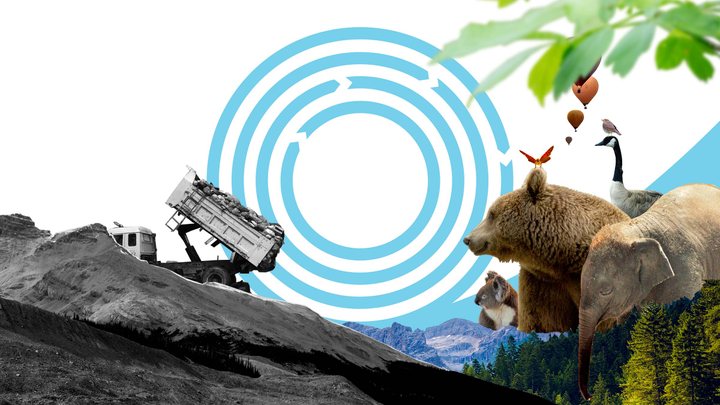Circular solutions can halt biodiversity loss – The food and agriculture sector can make the largest contribution

We are losing biodiversity at an alarming rate all over the world. The situation is serious because our health, economy and well-being are all utterly dependent on nature and the services it provides.
According to the recent study Tackling root causes – Halting biodiversity loss through the circular economy by the Finnish Innovation Fund Sitra, we already have the solutions to halt global biodiversity right in front of us – in the form of the circular economy. By designing out waste, by making products that last and by keeping those products in active use as long as possible, we get more value from what we have. This also reduces the need to extract new natural resources, leaving more room for nature to thrive.
The study is the first to quantify the role a circular economy can play in tackling global biodiversity loss, targeting the four sectors with the largest impacts. To do this, Sitra teamed up with experts from Vivid Economics.
The potential of the circular economy is significant: circular interventions in the food and agriculture, construction, textiles and forest sectors can halt biodiversity loss even if no other action is taken. And more than that, the study finds that the world’s biodiversity can recover to 2000 levels by 2035, if the circular interventions are implemented.
“It is possible to halt biodiversity loss, but it requires significant changes in how we produce, consume and manage products and materials. The circular economy offers solutions, and the best thing is that these solutions are ready to be used,” says Kari Herlevi, Project Director at Sitra.
Food – the biggest challenge but the greatest potential
According to the study, the sector where circular interventions can have the largest positive impact is food and agriculture. Merely by shifting to more alternative proteins and regenerative agriculture, and by reducing food waste by half, biodiversity loss could be halted by 2035.
In practice, the transition to a circular economy in the food and agriculture sector will make it possible to produce the food humanity consumes on a much smaller area of agricultural land and with fewer inputs such as fertilisers, leaving more room for nature to thrive. According to the study, which captures the impacts on biodiversity from changes in land use, the circular interventions examined could free up land corresponding to as much as 1.5 times the size of the European Union for other uses by 2050.
To make the transition possible, the circular economy should be harnessed as a tool for halting biodiversity loss by both businesses and policymakers, by the following means.
First, the circular economy should be integrated into all decision-making and strategies.
Second, the emphasis should be on circular interventions that effectively halt biodiversity loss and at the same time mitigate climate change. According to the study, many circular interventions that tackle biodiversity loss also reduce greenhouse gas emissions, not least those solutions that give us more value from our biomass, including substituting alternative proteins for meat and reducing food waste – these are the two solutions in the study with the most impact and are also practices that people can easily adopt. In the food and agriculture sector, the transition to a circular economy would reduce methane emissions from agriculture by as much as 90 per cent by 2050.
Both these means will also be addressed in this year’s World Circular Economy Forum, which will be held in Rwanda and online at the end of the year.
“Biodiversity loss is a challenge that may even eclipse climate change in the years to come, and thus far we are not doing nearly enough,” says Herlevi. “The good news is that the circular economy has largely been an overlooked opportunity, even though we already have the circular solutions right in front of us. We can halt the biodiversity decline before it is too late, even as early as the next decade.”
“The planetary boundaries are all deeply connected, but climate and biodiversity are core boundaries. They impact on all others,” says Johan Rockström, Director of the Potsdam Institute for Climate Impact Research, who will give a keynote speech to a Sitra webinar on 13 June, where the results of the study will be discussed. “The next 10 years must see the most profound transformation the world has ever known.”
Read the study: https://www.sitra.fi/en/publications/tackling-root-causes
Join our webinar on 13 June to hear Johan Rockström’s keynote speech and to find out more about the results of the study. Registration will be open until the start of the webinar. Register here: https://www.sitra.fi/en/events/tackling-root-causes-halting-biodiversity-loss-through-the-circular-economy
Keywords
Contacts
Kari Herlevi, Project Director, Circular Economy for Biodiversity Sitra
kari.herlevi@sitra.fi, +358 (294) 618 287
Tim Forslund, Specialist, Circular Economy for Biodiversity Sitra
tim.forslund@sitra.fi, +358 (294) 618 475
Samuli Laita, Leading specialist, Communications and public affairs, Sitra
samuli.laita@sitra.fi, +358 (294) 618 277
Images

Links
About Sitra
Sitra is a future fund that collaborates with partners from different sectors to research, trial and implement bold new ideas that shape the future. Our aim is a Finland that succeeds as a pioneer in sustainable well-being.
Subscribe to releases from Sitra
Subscribe to all the latest releases from Sitra by registering your e-mail address below. You can unsubscribe at any time.
Latest releases from Sitra
WCEF2024: Europa behöver snarast en cirkulär inre marknad för att trygga den ekonomiska säkerheten18.4.2024 09:32:48 EEST | Tiedote
EU tillkännagav inrättandet av ett nytt resurscentrum för cirkulär ekonomi, som utvecklats tilsammans med Sitra.
WCEF2024: Euroopan talouden turvaaminen tarvitsee kiertotalouden mukaiset sisämarkkinat18.4.2024 09:32:48 EEST | Tiedote
EU perustaa uuden kiertotalouden osaamiskeskuksen, jonka se on kehittänyt yhdessä Sitran kanssa.
Cirkulära lösningar motverkar förlusten av biologisk mångfald och skapar nya affärsmöjligheter – se Europas topp 30-lista15.4.2024 16:15:00 EEST | Tiedote
En lista med 30 europeiska företag, som presenterades vid World Circular Economy Forum 2024 i Bryssel, visar hur cirkulära lösningar kan minska förlusten av biologisk mångfald och öppna upp nya affärsmöjligheter. Vid sidan av listan släpper framtidshuset Sitra en handbok som är den första i sitt slag för att utveckla affärsmodeller för cirkulär ekonomi för att uppnå naturmålen.
Kiertotalous torjuu luontokatoa ja luo uutta liiketoimintaa: Katso Euroopan 30 edelläkävijän lista, mukana useita suomalaisyrityksiä15.4.2024 16:15:00 EEST | Tiedote
Yritykset voivat luoda uutta liiketoimintaa kiertotalousratkaisuilla ja torjua samalla luontokatoa. Tämä selviää 30 eurooppalaisen edelläkävijäyrityksen listauksesta, joka julkaistiin Maailman kiertotalousfoorumissa WCEF2024:ssä Brysselissä maanantaina. Samalla tulevaisuustalo Sitra esitteli uraauurtavan käsikirjan, joka opastaa yrityksiä luontoa vahvistavan kiertotalousliiketoiminnan kehittämisessä.
Circular solutions tackle biodiversity loss and unlock business growth – see Europe’s top 30 list15.4.2024 16:15:00 EEST | Press release
A list of 30 European companies, unveiled at the World Circular Economy Forum 2024 in Brussels, shows how circular solutions can tackle biodiversity loss and unlock new business opportunities. Alongside the list, the Finnish Innovation Fund Sitra released a first-of-its-kind handbook for developing circular economy business models to deliver on nature targets.
In our pressroom you can read all our latest releases, find our press contacts, images, documents and other relevant information about us.
Visit our pressroom
